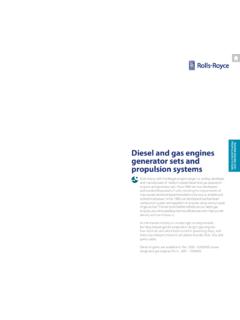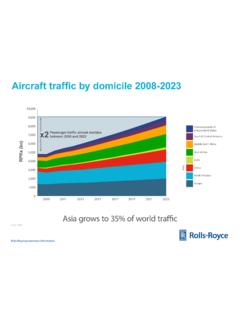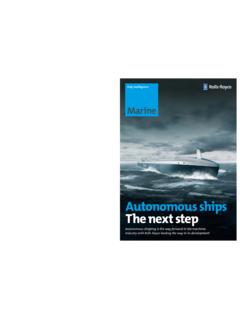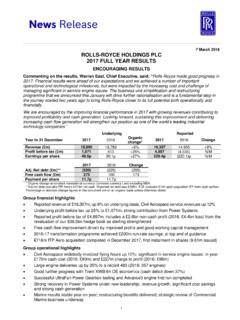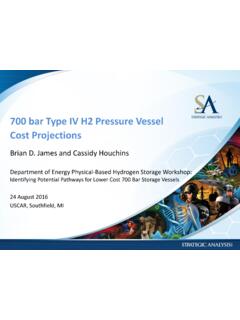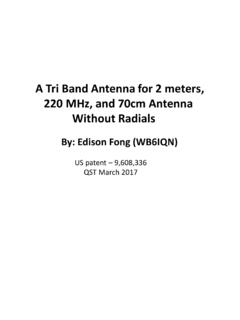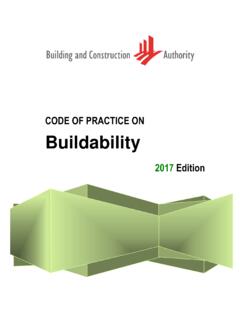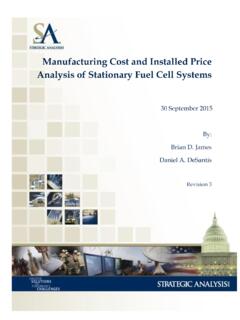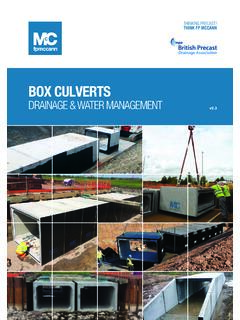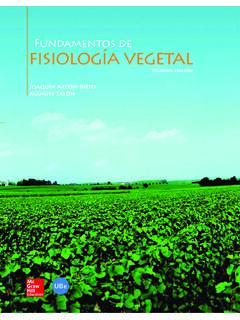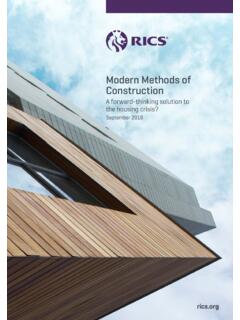Transcription of How to Design for Manufacture and Assembly
1 How to Design for Manufacture and Assembly Value Chain Competitiveness (VCC). Version: 1. December 2019. This information is provided by Rolls-Royce in good faith based upon the latest information 2019 Rolls-Royce | Not Subject to Export available to it; no warranty or representation is given; no contractual or other binding Control commitment is implied. 2. How to Design for Manufacture and BACK Map NEXT. Assembly Scope Objectives & Principles Prerequisites 1. Understand Gate 2. Apply Design Gate Design for Start Check for Manufacture Check Manufacture and list list and Assembly '. Assembly '. End 2019 Rolls-Royce 3. Scope BACK Map NEXT. This How To' will enable you to: Identify and review the inputs needed to conduct appropriate Design for Manufacture and Assembly (DFMA) at different stages of the product lifecycle Design for Manufacture guidelines Design for Assembly guidelines DFMA team members with knowledge and experience in cross-functional disciplines The product, manufacturing and Assembly requirements Approach to conducting DFMA reviews for action capture and closure 2019 Rolls-Royce 4.
2 Objective and Principles BACK Map NEXT. 1. DFMA influences Design definition 2. Design for Assembly aims to in the early stages of the product reduce the number of parts, development easing handling and Assembly operations Design for Manufacturing and Assembly (DFMA). Influence on Cost / Quality / Time: 4. DFMA utilises cross-functional 3. Design for Manufacturing aims to knowledge and experiences for select the most cost effective idea generation and action material and process to ease implementation manufacturing operations 2019 Rolls-Royce 5. Prerequisites BACK Map NEXT. Knowledge: Existing Design development process and potential benefits of adopting a DFMA approach 2019 Rolls-Royce 6. 1. Understand Design for Manufacture and BACK Map NEXT. Assembly '. Understand the process for DFMA. 8 parts, 20 processes 2 parts, 6 processes Concept Design Design for Manufacture and Assembly Detailed Design Design for Manufacture and Assembly (DFMA). To minimise product cost from product Design through its life-cycle Resulting in simpler products, collaboration in Design & Manufacture , lean thinking A.
3 Design for Assembly (DFA). Design the products for ease of Assembly Focusing on the number of parts, handling and ease of Assembly operation B. Design for Manufacturing (DFM). Design the components / products for ease of Manufacture Selecting the most cost effective material and process to be used in production 2019 Rolls-Royce 7. 1. Understand Design for Manufacture and BACK Map NEXT. Assembly '. Deign for Manufacture and Assembly Functional Analysis Functional analysis is a Design method providing a complete view of Design in terms of functions and relationships of those functions Example functional analysis of a ball point pen Advantages of functional analysis The product intended use is examined thoroughly giving a better understanding of the user and customer The technique aids creative thinking and idea generation (innovation). before selecting the best Design solution It enables the identification and definition of modular functions, promoting the definition of modular product Design and components Modular Design 2019 Rolls-Royce 8.
4 1. Understand Design for Manufacture and BACK Map NEXT. Assembly '. Design for Assembly - Determine the parts requirement Reduce the number of unique parts, asking Must the part move relative to other parts already installed in the Assembly ? It is only unique if movement is essential for product function Must the part be made of different material? - It is only unique if material type is essential for product fit, form or function Must the part be separate from other parts? It is only unique if there is a separation requirement for in-service Parts List adjustment or replacement 2019 Rolls-Royce 9. 1. Understand Design for Manufacture and BACK Map NEXT. Assembly '. Design for Assembly - Determine parts standardisation & practical minimum number Can the parts be standardised? Within the Assembly station Within the full Assembly Within the Assembly plant Within the company Determine the practical minimum number of parts Team assessment of practical changes start point Trade-offs between part cost and Assembly cost Increasing creativity rate required towards theoretical min.
5 No. of parts Cost focus: Minimising number of parts and extra sizes reduces both inventory and confusion during Assembly 2019 Rolls-Royce 10. 1. Understand Design for Manufacture and BACK Map NEXT. Assembly '. Design for Assembly - Determine parts presentation for ease of Assembly Design out jamming and tangling Avoid nesting &. tangling Avoid too small or too large Avoid small items requiring precision placement Symmetry eliminates reorientation Design for part symmetry 2019 Rolls-Royce 11. 1. Understand Design for Manufacture and BACK Map NEXT. Assembly '. Design for Assembly - Determine parts handling requirements Considering the current handling techniques: based on Assembly process and complexity of parts How many hands are required? Is any grasping assistance needed? What is the effect of part symmetry on Assembly ? Is the part easy to align/position? Part handling considerations Size Sharpness Thickness Stickiness Nesting Requires two hands Weight Requires grasping tool Tangles Requires magnification to be seen Fragile Requires mechanical assistance Slippery 2019 Rolls-Royce 12.
6 1. Understand Design for Manufacture and BACK Map NEXT. Assembly '. Design for Assembly - Determine parts insertion requirements Considering the current insertion (locate & secure) techniques: based on difficulty required for each component insertion a Is the part secured immediately upon insertion? Is it necessary to hold down part to maintain location? Is the part easy to align/position? Part insertion considerations b c a) Self-aligning parts b) Self locating parts c) Adequate access and visibility d) One way orientation d e e) Avoid reorientation during Assembly Keyway ensures correct orientation No reorientation 2019 Rolls-Royce 13. 1. Understand Design for Manufacture and BACK Map NEXT. Assembly '. Design for Assembly - Determine parts insertion requirements When using mechanical fasteners, attempt to use the lowest cost method: Snap fitting Plastic flexing Riveting Screwing Design in the fastener Use snap together designs Standardise fasteners 2019 Rolls-Royce 14. 1.
7 Understand Design for Manufacture and BACK Map NEXT. Assembly '. Design for Assembly - Design for mistake proof Assembly Design in mistake-proofing in to Assembly to prevent wrong parts being assembled parts being omitted a assembling parts in the wrong orientation e Bosses Examples include using b a) Bosses b) Tapers c) Locating holes Tapers d) Part symmetry Asymmetry c e) Part asymmetry d Locating holes Symmetry 2019 Rolls-Royce 15. 1. Understand Design for Manufacture and BACK Map NEXT. Assembly '. Design for Assembly - Secondary operations and other considerations Eliminate secondary operations Assemble in single axis (from above) - screw, twist, rivet, bend, crimp Eliminate operations - weld, solder, glue, paint, lubricate, test, measure, adjust Screw down from above Rivet Other considerations Avoid connections Eliminate restricted access for operations Avoid adjustments Minimise part variation Eliminate restricted access 2019 Rolls-Royce 16. 1. Understand Design for Manufacture and BACK Map NEXT.
8 Assembly '. Design for Manufacture - Considerations for ease of Manufacture When selecting the manufacturing methods: Is hard tooling required? Have we selected the best technology or process to fabricate parts? Have we selected the best material needed for function and cost? Have we looked at all the new technology that is available? Are the parts shaped for the implementation of automation? Is the supplier capable of meeting the specifications? Other considerations Parts reduction strategy reducing manufacturing costs through less purchases, inventory, handling, processing time, development time, equipment, engineering time, inspection, testing, etc. Raw material choices Lowest cost choices can drive up the number of materials. Choosing a material with better machining characteristics might result in lower processing costs offsetting higher material cost. 2019 Rolls-Royce 17. 1. Understand Design for Manufacture and BACK Map NEXT. Assembly '. Design for Manufacture - Standardising Materials Standard stock sizes Develop a common set Standard material types and properties Develop a common set Pre-shaping Develop forming requirements & work with suppliers 2019 Rolls-Royce 18.
9 1. Understand Design for Manufacture and BACK Map NEXT. Assembly '. Design for Excellence Design for' (DFX) is not limited to Assembly ' (DFA) or Manufacture '. (DFM), there are other types for example Design for Performance Testability Serviceability Design for Reliability Service (DFS). Yield Six Sigma Collectively known as DFX. 2019 Rolls-Royce 19. Gate checklist 1: Understand Design for BACK Map NEXT. Manufacture and Assembly '. A better understanding gained of Design for Assembly (DFA) and benefits for ease of Assembly operations A better understanding gained of Design for Manufacture (DFM) and benefits for ease of manufacturing operations Awareness of other Design for' activity available through DFX. 2019 Rolls-Royce 20. 2. Apply Design for Manufacture and BACK Map NEXT. Assembly '. Start Early & Do Regularly Generate Ideas Design Concepts Design Actions Manufacturing Concepts Manufacturing Actions Historical Problems Design for Manufacture and Assembly is a continuous improvement cycle of activity starting at concept Design through to final definition It requires a cross-functional input for effective idea generation and action The activity needs time & focus, benefiting from facilitation It is a data-driven activity using existing knowledge and experience Benefits are only gained through robust action taking and close-out 2019 Rolls-Royce 21.
10 2. Apply Design for Manufacture and BACK Map NEXT. Assembly '. Manufacturing Technology Planning Define Potential Technologies Design for Manufacture starts with a good understanding of product functionality and the functional features and the capabilities of manufacturing technology options. Manufacturing Manufacturing Engineering Input of Engineering Technology Technology Data Potential Functional Base Technology attribute Technology Sequences Cost Description Performance Method Design Core Engineering Technology Technology Input of Product Selection Selection Characteristics Product Product Data Base Description Technology A-B-C. Technology Selection Technology A-D-C. Technology F-D-H. 2019 Rolls-Royce 22. 2. Apply Design for Manufacture and BACK Map NEXT. Assembly '. Match Manufacturing Process to Product Features Match manufacturing process to product functional features Define Functional Features Conduct Design for Manufacture & Assembly Identify product functional features Select Technologies based upon their capability to produce the products functional Make Features Select Best features.

